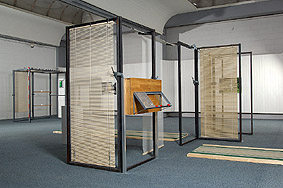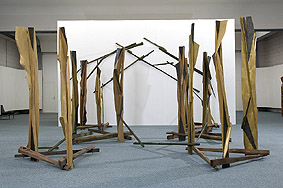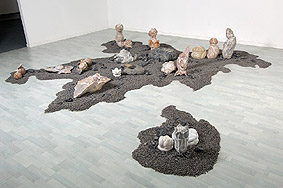Roman Makše , Dragica Čadež & Jiāi Bezlaj
3 June - 3 July, 2005

Roman Makse, 2005, ZaAM
The Palace at 4 a.m. (Abstract)
by Jernej Kozar
ROMAN MAKŠE
In his sculptures, installations and environments, Roman Makše displays typical features of contemporary styles of dwelling. The format of these sculptures, which recalls the similar format of contemporary homes, is a constant in Makše's work. These sculptures do not hide their ambivalence. On the one hand, they tell a clear and linear story; on the other, however, Makše uses all these tiny details in an aesthetic way, as well, merely as compositional elements in which we can detect echoes of the most influential style of the twentieth century, namely, minimalism. The window blinds, handles and knobs, the wooden flooring, the carpet runner, and the cushioned furniture, among other things, work together in the sculpture on at least three levels. First, as an art medium, whereby the artist establishes a pure three-dimensional form, they demarcate the boundary between outside and inside. Then, as signs by means of which the viewer projects his associations onto the surface of the sculpture, they produce a representation of familiar objects. And finally, as readymades, they simply are what they are. The interweaving of these semiotic functions gives the sculpture its peculiar dynamic and ironic distance.
Makše's sculptures are neither real functional objects nor clear representations. They are everyday objects with representational elements added. There is no exact correspondence between signifier and signified or referent; rather, the production of meaning takes place within a system of other signs. The relation between signifier and signified is arbitrary. It functions on a number levels and is continually opening up new interpretations; meanwhile, the viewer projects his subconscious onto the given form. Since, for each of us, the subconscious is subordinate to our own experiences, it is therefore entirely individual, linked only to certain constants, which we know as social taboos. The metaphorical connections to the object prompt the viewer's subconscious projections and invite him to summon into consciousness an internalized fantastic story previously unknown to him.

Dragica Cadez, 2005
DRAGICA ČADEŽ
The work of Dragica Čadež is based on similar aesthetic principles as that of Makše. Her sculptures, too, stand on the floor and extend into the space that surrounds them, which makes their physical presence more emphatic. As a result, we see the sculpture as a real object, with its own abstract identity, rather than as an image or representation of something.
Čadež arranges planes and lines in vertical and horizontal positions so as to create various rhythms and configurations. The work has no permanent visual identity and no center of identification. It develops and expands into the viewer's space in a way that makes its appearance change depending on the point from which it is viewed. The artist uses color to connect individual elements, thus creating a sculpture where the individual components function like notes in a musical composition.
Dragica Čadež comes from the neo-constructivist tradition of the third quarter of the twentieth century. The structure of the work is always apparent; we are able to follow the sculpture's logic, first, at the time of its creation and, then, even more importantly, in the development of the form in concrete space. The boards from which these works are made preserve their natural forms, forms that Čadež in some places emphasizes and in other places conceals, though their origin in nature is never hidden. For this reason, associations with forests and trees are not unusual. Čadež, of course, blurs such direct associations, sometimes through her use of color or through the composition of the individual parts, which, as we said, comes from the modernist tradition. Like Makše, Čadež also makes her sculptures by putting things together; with Čadež, however, these compositions are subordinated solely to aesthetic demands. Here the story is of secondary importance. Although it never completely vanishes and Čadež makes no attempt to avoid it, still, she never lets the story come to the fore. Her sculptures, as well, have come down from the pedestal of a different reality and entered the space of the viewer, where they speak to him directly.

Jiri Bezlaj, 2005, Poletje
JIØI BEZLAJ
Bezlaj's sculptures are made from the traditional sculptural material of marble, which raises them into the sphere of classical art. Nevertheless, today they function on symbolically, and perhaps even ironically in our consumerist world dominated by replaceable objects. The intimate stone shapes remind us of flowers, ornaments, organic forms, parts of the body, torsos - and this transforms the installation of Bezlaj's sculptures into a kind of lapidary gallery, that is, a collection of diverse sculpture fragments not necessarily all belonging to the same period. Of course, Bezlaj's installation is hardly chaotic. On the contrary, this is an intelligently organized whole that follows certain artistic principles and viewing strategies. The smooth, polished surface of the stone triggers in us an ambivalent response, especially when, in the stone mass, we recognize part of a body that seems to be meant for touching, for the erotic, but which is in this case only for viewing and observation. A special element in the installation of these sculptures is the sand on which unworked pieces of stone have been arranged, serving, as it were, as a pedestal, which shifts the narrative back into the sphere of art history.
From blocks of stone Bezlaj shapes organic forms - upright sculptures, which at the top usually turn into a flower, a bud, or a stylized rosette. In other places, the stone might remain rough, so that what we see in front of us is always, to some degree, an unfinished work, a torso.
Bezlaj builds on ideas of growth and transformation as a double metaphor. The inorganic material of the marble has been permeated from within by an animating force. At the same time, this vessel of metaphor is permeated by a current that transforms it from rigid lifeless matter into organic tissue. It endows it with a kind of unstable and mobile surface that lives its own life, divorced from the benumbed core. These sculptures are petrified organic forms, frozen in time, and they project illusion through time-limited organic change. Bezlaj's concept of sculpture is directed toward the viewer's sense of touch as an instinctive and sensate extension of his capacity for thought. Bezlaj's work is thus linked with the modernist tradition of vitalist sculpture, initiated by Jean Arp and then continued by Henry Moore and Barbara Hepworth.
Curator: Jernej Kožar
![]()
![]()